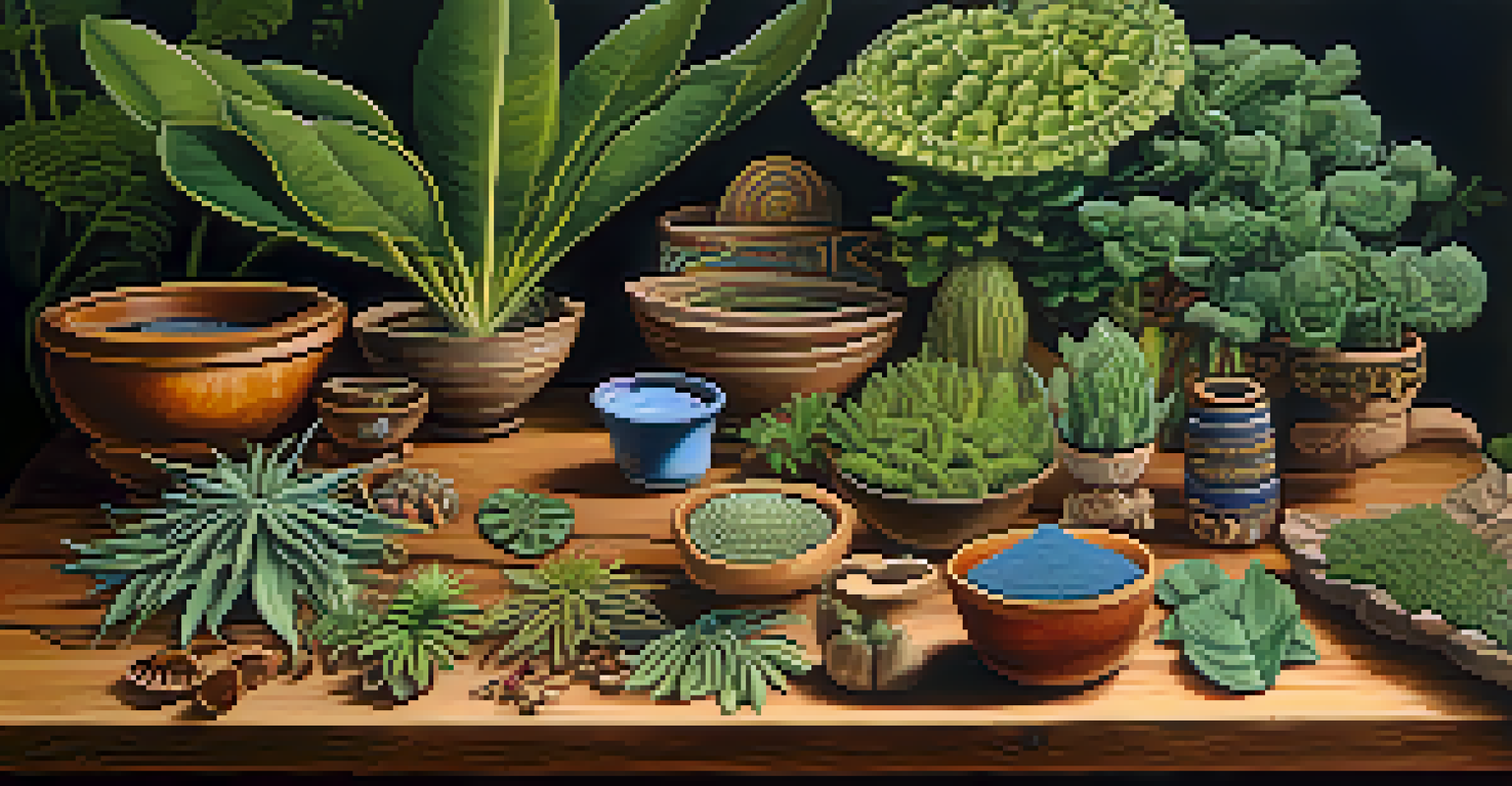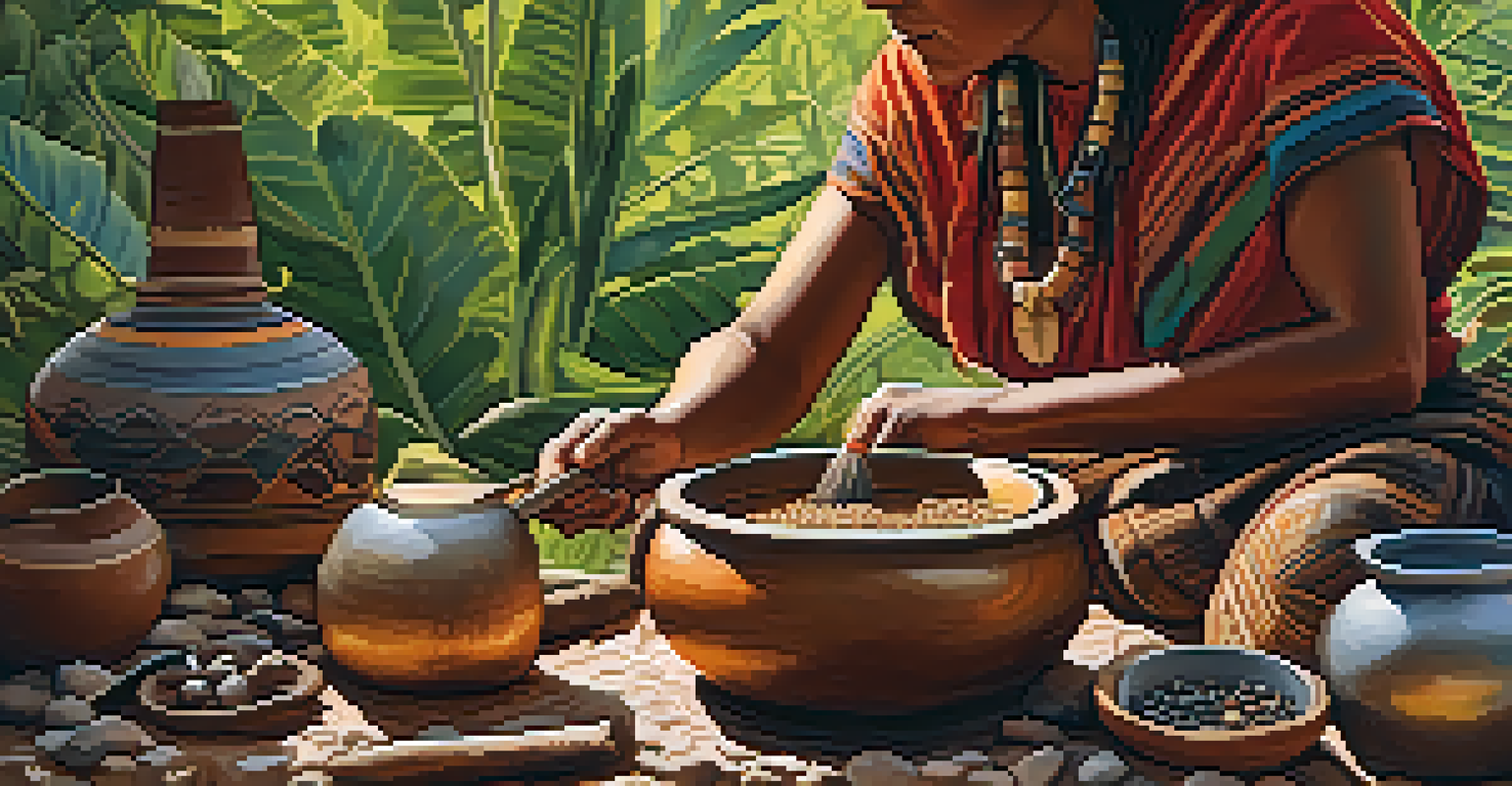Navigating Modernity: Entheogens in Indigenous Resilience

Understanding Entheogens and Their Cultural Significance
Entheogens are substances that induce spiritual experiences, often used in religious or shamanic contexts. For many Indigenous cultures, these plants and fungi, like peyote and ayahuasca, are deeply woven into their spiritual fabric. They serve not just as tools for healing, but as gateways to understanding one's place in the universe.
The use of entheogens is not only about the individual experience but also about the community's collective journey toward healing and understanding.
The use of entheogens is more than a ritual; it reflects a worldview that values interconnectedness and respect for nature. This perspective is crucial for Indigenous communities, especially in a world that often prioritizes individualism over community. By embracing these substances, they reaffirm their cultural identity and traditions.
In the face of modern challenges, the cultural significance of entheogens is being recognized anew. They are not merely relics of the past but are actively used to navigate contemporary issues such as mental health, land rights, and cultural survival. This resurgence highlights the resilience of Indigenous peoples in retaining their heritage.
Modern Challenges Facing Indigenous Communities
Indigenous communities today face numerous challenges, including land dispossession, cultural erosion, and systemic inequality. These issues have far-reaching effects on their mental and physical health, often leading to high rates of depression and substance abuse. Understanding these challenges is crucial for appreciating the role of entheogens in fostering resilience.

As traditional ways of life are threatened, many Indigenous peoples are turning to entheogens as a means of reconnecting with their heritage and ancestry. This revival serves as a source of strength and a way to combat the disconnection caused by modernity. It’s a powerful reminder that looking to the past can provide solutions for the future.
Cultural Significance of Entheogens
Entheogens play a vital role in Indigenous cultures, serving as tools for healing and spiritual connection.
Moreover, the intersection of modernity and tradition creates a unique space for innovation within Indigenous communities. By blending ancient practices with contemporary issues, they are crafting new narratives that empower their youth and preserve their culture. This adaptability is a key component of their resilience.
The Healing Properties of Entheogens
Research has shown that many entheogens have therapeutic effects, particularly in treating mental health conditions. Substances like psilocybin and ayahuasca have been found to facilitate profound healing experiences that can help individuals process trauma. This is especially relevant for Indigenous peoples who have faced generations of trauma due to colonization.
Indigenous knowledge systems are not just relics of the past; they are living practices that can guide us toward a more harmonious future.
These healing properties have led to a resurgence in interest from both Indigenous and non-Indigenous communities. Workshops and ceremonies are being held to share knowledge and experiences surrounding entheogens. This not only fosters community healing but also raises awareness about the importance of preserving these practices.
Additionally, the use of entheogens in a supportive community environment can enhance the overall therapeutic experience. Participants often find a sense of belonging and understanding that contributes to their healing journey. This communal aspect is integral to the resilience of Indigenous cultures.
Entheogens as Tools for Cultural Revitalization
Incorporating entheogens into cultural practices can serve as a powerful means of revitalization for Indigenous communities. By reclaiming these ancient practices, they reinforce their identity and connection to their ancestors. This process not only honors their heritage but also inspires younger generations to engage with their culture.
Cultural revitalization through entheogens can take many forms, including traditional ceremonies, art, and storytelling. These expressions serve as a reminder of the richness of Indigenous knowledge and its relevance in today's world. They also provide an opportunity for cross-cultural dialogue and understanding.
Modern Challenges for Indigenous Peoples
Indigenous communities face significant challenges, including cultural erosion and systemic inequality, which entheogens help address.
Furthermore, this revitalization can contribute to the broader movement of decolonization, as Indigenous peoples reclaim their narratives. It empowers them to define their relationship with land, spirituality, and identity, reinforcing their rightful place in society. This is a testament to the enduring spirit of Indigenous resilience.
Legal and Ethical Considerations of Entheogen Use
The legal landscape surrounding entheogens is complex and varies widely across jurisdictions. Many Indigenous communities advocate for the right to use these substances as part of their cultural practices. This raises important ethical questions about ownership, access, and the commercialization of sacred traditions.
In recent years, there has been a growing movement to recognize the religious and cultural significance of entheogens. Legal battles and advocacy efforts are underway in many regions to protect Indigenous rights. This push for recognition not only validates their practices but also emphasizes the importance of cultural sovereignty.
Navigating these legal and ethical challenges requires careful consideration and respect for Indigenous knowledge systems. Collaborative efforts between Indigenous communities and allies can help ensure that entheogen use is approached with sensitivity and respect. This collaborative spirit is essential for fostering understanding and mutual respect.
The Role of Allies in Supporting Indigenous Resilience
Allies play a crucial role in supporting Indigenous communities as they navigate modern challenges. This support can take various forms, from amplifying Indigenous voices to advocating for policy changes that respect their rights. Allies must approach this relationship with humility and a willingness to learn from Indigenous perspectives.
By respecting the traditions and practices surrounding entheogens, allies can help create a more equitable space for dialogue and collaboration. This involves understanding the cultural significance of these substances and the histories that inform their use. Building trust and rapport with Indigenous communities is essential for effective allyship.
Healing and Resilience Through Tradition
The therapeutic properties of entheogens foster community healing and cultural revitalization among Indigenous peoples.
Moreover, allies can contribute to the preservation and revitalization of Indigenous practices by sharing resources and creating platforms for Indigenous voices. This collaborative approach fosters a sense of community and shared purpose, reinforcing the resilience and strength of Indigenous peoples in their journey forward.
Looking Ahead: The Future of Entheogens in Indigenous Culture
The future of entheogens in Indigenous culture is bright, as more communities embrace these practices as tools for healing and resilience. As awareness grows, there is potential for greater acceptance and integration of entheogens into both Indigenous and non-Indigenous wellness practices. This shift could pave the way for a deeper understanding of the importance of these substances.
Continued research into the therapeutic effects of entheogens may further validate their use, leading to more supportive policies and practices. This could result in increased access to traditional healing methods for Indigenous peoples, enhancing their resilience in the face of ongoing challenges. The integration of science and tradition can create a holistic approach to wellness.

Ultimately, the journey of entheogens within Indigenous cultures is not just about resistance, but about thriving. By reclaiming their narratives and practices, Indigenous communities are not only preserving their heritage but also shaping a future where they can flourish. This ongoing resilience stands as a powerful testament to their enduring spirit.